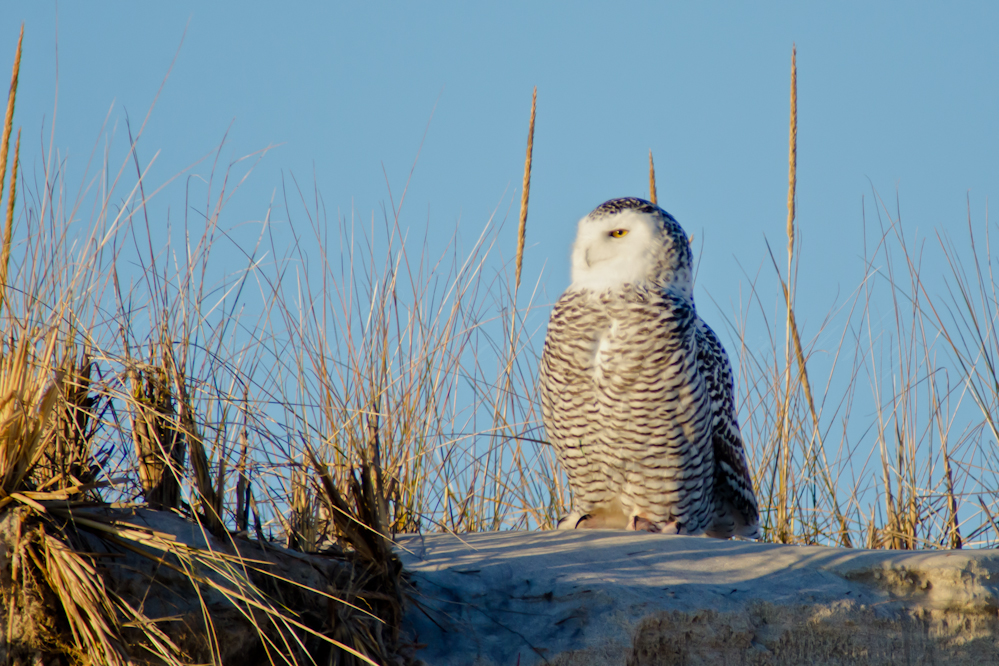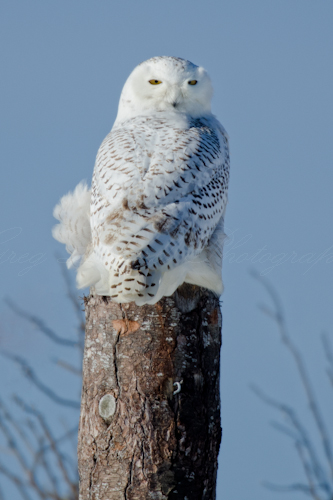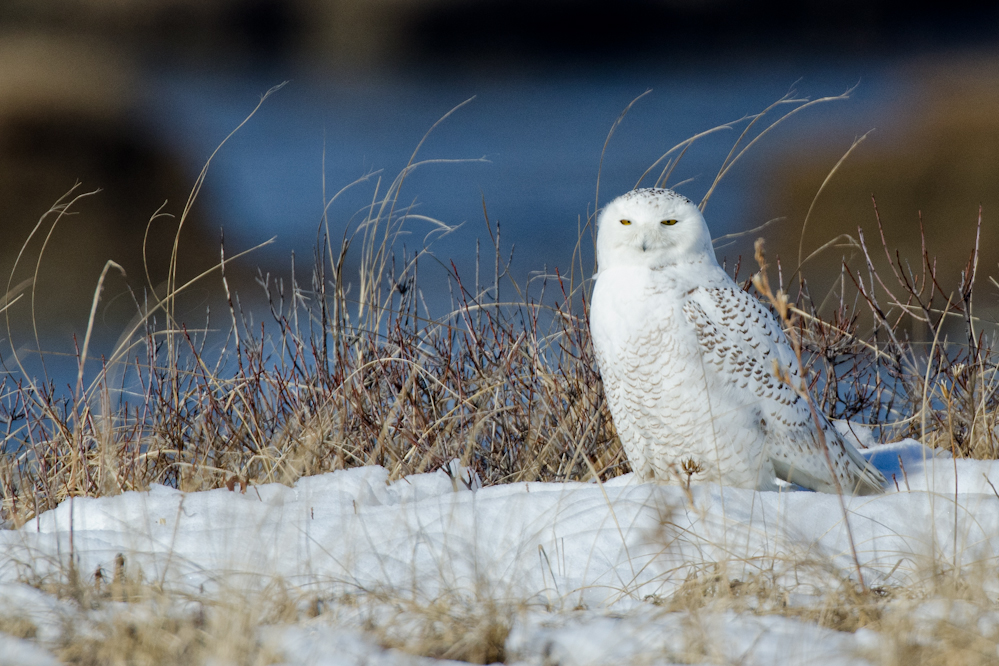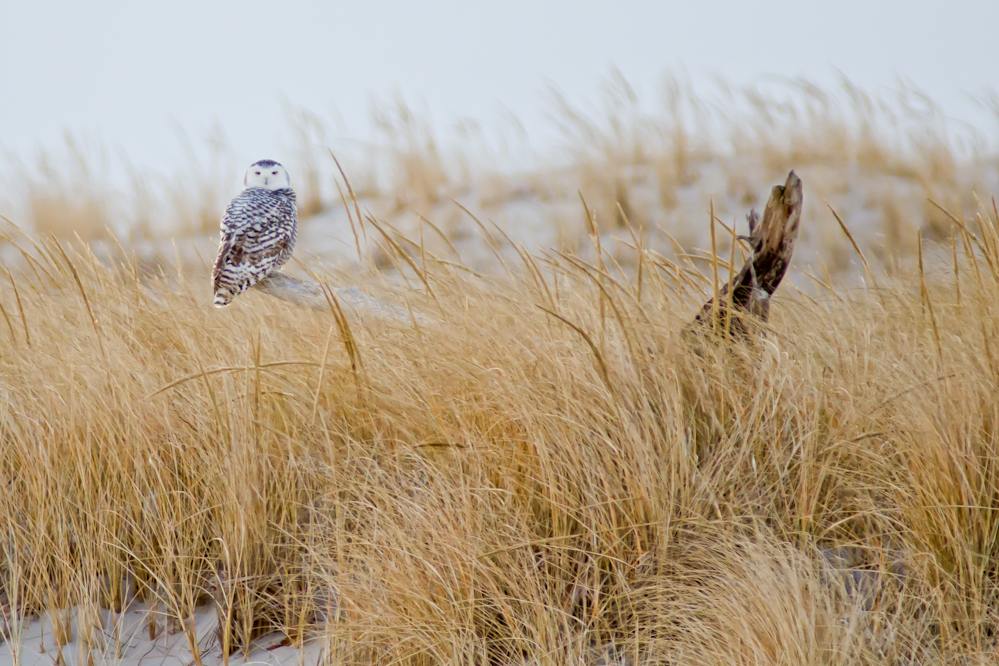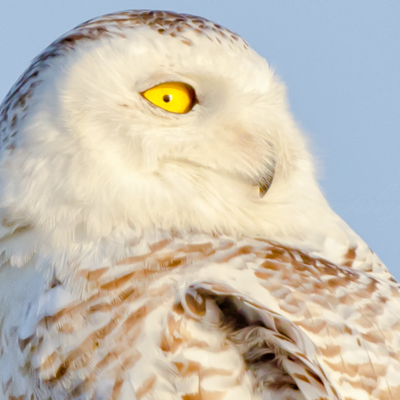The winter of 2013-14 was a record year for snowy owls in New England. More owls were seen in Massachusetts than had ever been seen before. It seemed that they were everywhere.
No one is exactly sure why the irruption occurred. The prevailing wisdom is that there was a large increase in the lemming population of eastern Canada. This strong food source caused the owls to breed in high numbers. One owl’s nest was reported to have more than seventy lemmings stacked in a ring around a few unhatched eggs. It was obvious that those parent owls would be able to feed their young and ensure their survival. It is believed that as winter set in, the lemming population dropped due to predation. This in turn caused all of the young owls to head to warmer climates in search of food. Many of them came to New England.
I have been intrigued by snowy owls for many years. Their elusive nature and beauty are irresistible to this photographer. The challenge of making a great image of snowy owls continues to engage me.
During the winter of 2013-14, I had seen so many owls that I had become very discerning about which owls I would photograph. I had specific images in mind. At the outset of the winter, I had not seen a darkly barred snowy owl before and I was very excited to photograph them. The dark bars or spots on their feathers imply that the owls are either female or very young or perhaps both. With so many young darkly barred owls arriving in New England, it became a challenge to find an owl that was mostly white in coloration.
In late February, I was photographing a darkly barred owl resting in a tangle of thorns. The owl had settled down for a long winter’s nap and had not stirred for more than two hours. Then a jogger came by and told me that there was a completely white snowy owl nearby. The heavily barred owl I was watching was unlikely to move for a very long time, so I decided to look for the white owl.
After a brief search, I was delighted to spot a small, but beautiful, mostly white snowy owl perched on a pine fence pole. Based on its size and coloration, I assumed that it was a male owl. However, there is no way to accurately tell the sex of an owl for sure without capturing it. Male owls are typically smaller and paler than the females, but this is not always true. As I photographed this stunning owl, it flew from its perch and landed on a nearby snow covered dune. The more natural setting was very appealing and I was thrilled to create some excellent images.
This owl was on the prowl. It was very active, constantly moving around. At one point it scooped snow with its beak, presumably for a chilly winter drink. Within a few minutes the owl flew further away, but it had made my day!
To photograph this owl, I used a Nikon 600mm f4 lens and a Nikon D 7000 with a 1.5 crop sensor. That combination effectively functions as a 900mm f4 lens! This allowed me to keep a safe distance from the owl (more than 50 feet) and still make sharp and close images, without disturbing the owl.
It is my goal as a photographer to make great images. However, when photographing wildlife, I make sure that I keep the animal’s well-being as my first priority. Having the right equipment is critical. Snowy owls need their space. Keeping 50 -100 feet away from an owl requires a minimum of a 300mm lens on a crop sensor. That is for a distant scenic shot like the image below. To make great close-up images, longer lenses are required.
In addition to having a great lens and camera, you will also need a sturdy tripod. To handle the load of my Nikon 600mm f4 and my d7000, a little more than 12 pounds of gear, I use the Manfrotto 055 Aluminum 3-Section Tripod with Horizontal Column. This tripod has a great combination of excellent support and affordability. It supports more than 18 pounds of gear and it is very easy to use! Hunt’s is currently offering a 10% discount on this tripod to my workshop students. Please visit this link to receive the discount http://www.huntsphotoandvideo.com/detail_page.cfm?productid=MT055XPRO3&sp=jyEwv
Approaching a snowy owl is tricky business. Too fast, too tall, too excited, too close translates to stressed owls and missed photo opportunities.
All of us have our own comfort levels. Owls are no different. Imagine how comfortable you might be if you had a member of the paparazzi aiming his camera at you. If he is far away, you might not be bothered by the intrusion. But imagine him rushing at you, firing away. How close will you allow him to get before you either confront him or run away?
Now imagine that you are sunbathing on the beach. Then 5 photographers quietly crawl towards you on their stomachs, until they are 50 feet to your left. They keep snapping your photo, but they aren’t really bothering you too much. Still, it’s kind of creepy right?
The 5 photographers spend over an hour, firing multiple machine gun like shots each time you make the slightest movement. Then 7 more photographers arrive on your right, shouting and pointing and running right at you. Are you still feeling comfortable?
Most of us would have packed up our beach towel and picnic basket as soon as the first group of photographers tried to sneak up on us. A few of us might have called the police and the rest might actually enjoy having their picture taken.
So how do we get close to a snowy owl without scaring it away? Here are some tips:
1. Stay low. Snowy owls tend to stay relatively close to the ground, but they do like to be higher up than the rest of the creatures in their neighborhood. Crouch down until you are approximately 150-200 feet away from the owl. Then sit on your bum to slowly go the rest of the distance. If you can, you might try the good old belly crawl to approach the owl. At the very least kneel and crawl on all fours.
2. Move slow. The slower you approach an owl the better. When you come in for a fast landing, the owl has to quickly decide whether you mean to harm it or not. If you move slowly, this gives the owl more time to get used to you. In addition to moving slowly, stop every few feet to make a few images. This allows the owl to hear you taking the photos and hopefully get used to all of those strange clicking noises.
3. Keep your distance. Owls need their space. Stay at least 50 feet away from them.
4. Stay quiet. The more noise you make, the less comfortable the owl will be. Owls have fantastic hearing. While you think that you are quietly whispering, they are clearly hearing every word. Even at a great distance.
5. Be patient. Snowy owls often like to sit in one place for a very long time. Sometimes hours… Eventually the owl will do something interesting. Just wait for it… In the mean-time, please don’t call to the owl or try to flush it to get a flight shot.
6. Do not bait the owls. Do not use food of any type to attract an owl closer to you. Baiting is bad for the owls.
7. Try to approach the owl with the sun at your back. This will allow you to be on the “right” side of the light. This means that the owl will be well lit and not have its face in shadow and the background will be pleasant rather than harsh, blinding light.
8. Stay out of off limits areas. Owls will sometimes be in restricted areas. These areas are restricted for a reason. If the signs clearly say “Do not walk on the dunes”, please don’t walk on the dunes. Even if it means missing the shot. Even if no one is around. It only takes one person to ruin it for everyone.
9. If you follow all of these tips and you are still not close enough, try adding a 1.4 teleconverter. This will increase the size of the owl in your frame by 40%. Try using a high megapixel camera and crop the image closer in post processing.
10. Last, but not least, watch the owl’s behavior. If it seems nervous or agitated, do not approach any closer. The goal is to be able to view the owl without disturbing it.
I hope you find these tips helpful. Please keep the owls’ safety and comfort as your first priority when photographing them.
You can help support snowy owls by attending the Snowy Owl Project Auction on November 1, at Hunt’s Photo in Melrose. All proceeds will benefit the Snowy Owl Project. To find out more about this great event and the Snowy Owl Project, please visit this link: http://ebay.huntsphoto.com/the-snowy-owl-project/
Greg Lessard is a professional photographer. You can see his exhibit “Snowy Owls- Soul of the Arctic” at the South Shore Science Center in January. He will host an opening reception on January 10. To read more about photographing snowy owls, visit Greg’s blog at http://blog.greglessardphotography.com/
